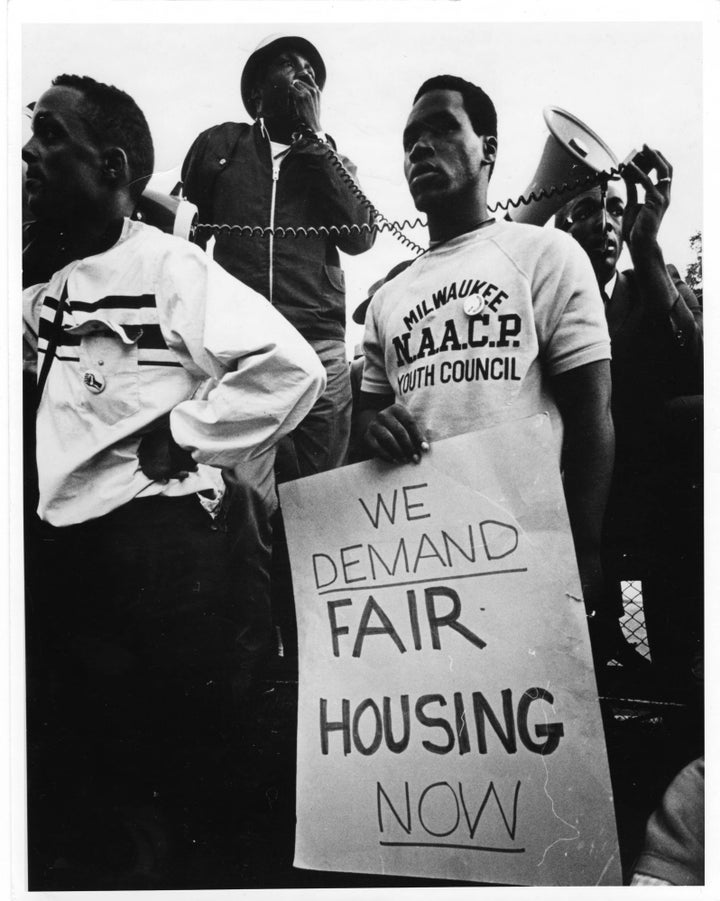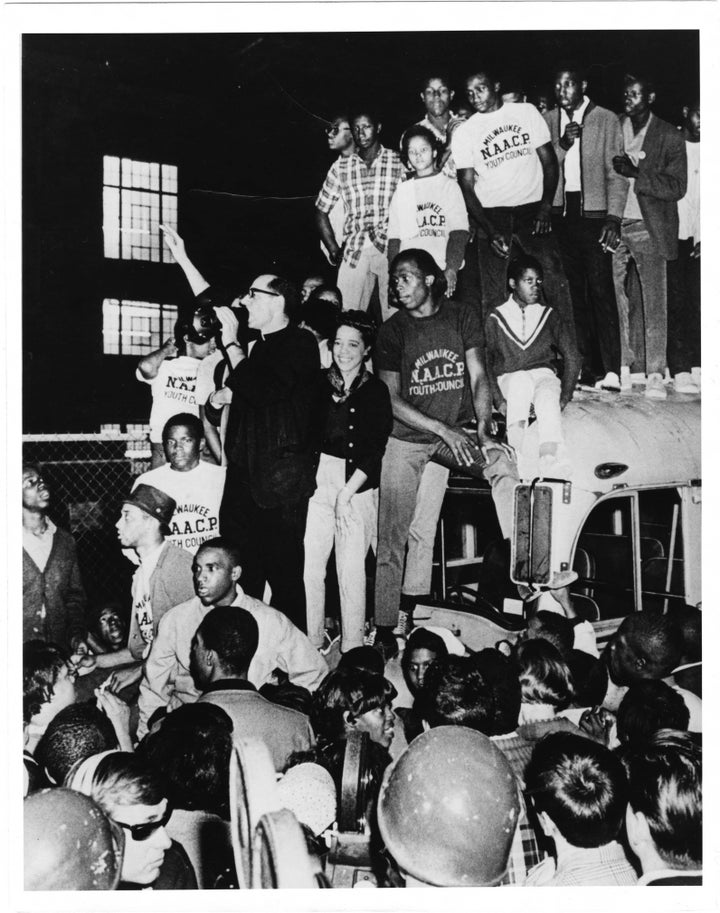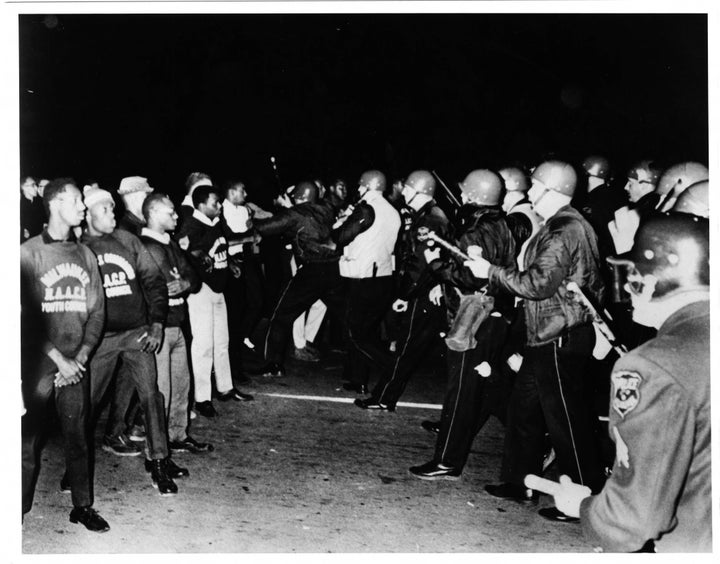
Note: This post contains language that may offend readers.
By Aug. 28, 1967, Black Milwaukee had grown tired and frustrated. Tired of living in substandard housing, tired of their overcrowded neighborhoods and tired of economic inequalities in their city, the young Black members of the National Association for the Advancement of Colored People’s (NAACP) Youth Council, the Commandos, and their adviser, Father James E. Groppi, joined forces with Alderwoman Vel Phillips. Together, they engineered a march to demand fair housing in Milwaukee.
And for 200 consecutive nights, they kept marching.
Fair housing in Milwaukee had been a primary concern for Black Milwaukeeans long before 1967. In the 1960s, the city of Milwaukee’s Black population was concentrated on the north side, which was colloquially referred to as the “inner core.” As Milwaukee’s Black population grew following World War II, and as manufacturing jobs began leaving the city, the inner core became overcrowded, and lax enforcement of the city’s building codes led to dilapidated housing.
Moreover, white landlords and homeowners outside of the inner core refused to rent or sell to African-Americans. “What would my neighbors think if I sold my home to niggers?” said one white homeowner to a then 19-year-old Prentice McKinney when he and his older brother, a Vietnam Vet, went to purchase a home for their mother.
Black people were essentially stuck in the inner core due to racist housing practices.
In 1962, Alderwoman Phillips, who made history in 1956 when she became the city’s first African-American ― and first woman ― to be elected to the Common Council, introduced a fair housing ordinance that would make it illegal to deny housing to African-Americans because of their race. Phillips hoped to put an end to racist housing discrimination through her fair housing ordinance.
The ordinance was voted down 17 to 1. Phillips was the sole vote in favor. The ordinance would continue to be voted down each of the three times she brought it up to the Common Council between 1962 and 1968.
By Aug. 28, 1967, Black Milwaukeeans, mobilized by their frustrations of living in a system where they lacked a political voice, took to the streets in peaceful protests. The first of 200 consecutive nights of marching began as 200 members of the NAACP Youth Council, the Commandos, Father James E. Groppi, Alderwoman Vel Phillips and at least 50 white parishioners from St. Veronica Church (on the south side, where Father Groppi had previously been an assistant pastor) marched from the predominately Black north side of Milwaukee to the predominately white south side of Milwaukee. The marchers were met by as many as 13,000 angry white counter-protesters, who hurled bottles, bricks, racial slurs and feces at participants. Archival footage from the marches capture how chilling and menacing the white backlash was to the peaceful protestors.
But intimidation tactics didn’t work. The marchers continued to demonstrate from late summer through Milwaukee’s brutal winter and into spring. The 200th march took place on March 14, 1968. The participants suspended their marches at that point but later staged the largest of their marches after the assassination of Martin Luther King Jr., who had early in the movement sent a note of support to the marchers.

On April 8, 1968, 15,000 people marched for Dr. King, continuing their approach to nonviolent protesting on which their movement had been built. On April 11, 1968, President Lyndon B. Johnson signed the Civil Rights Act, which had been influenced by the demonstrations in Milwaukee. And on April 30, 1968, the marchers achieved victory when Milwaukee’s Common Council passed the Fair Housing Ordinance that made housing discrimination in the city of Milwaukee illegal.
The March on Milwaukee (Aug. 28, 1967 through April 30, 1968) remains a radical act of civic participation. Radical because the marchers exercised a dynamic principal: the sustained engagement in public and peaceful protest by the city’s most overlooked population ― the poor, Black and/or young people of Milwaukee.
“The marchers were met by as many as 13,000 angry white counter-protesters, who hurled bottles, bricks, racial slurs and feces at participants.”
Despite the radical nature of the marches, this era of the city’s history has been almost erased from the local and national consciousness. The erasure has been both physical and metaphorical, as the physical buildings most important to the struggle for open housing, such as St. Boniface Parish, were torn down. As a current local organizer and community member, Adam Carr, has stated, it is as though the city suffers from a “collective amnesia.” The marches have been collectively forgotten and with them the radical legacy of Black, poor, and youth-led organizing in our city. This collective amnesia is unsurprising when one remembers that Milwaukee continues to be the nation’s most segregated metropolitan area.
Fifty years later, the anniversary of the March on Milwaukee provides a time for the city to both recognize and reignite the spirit of the original marches ― to build the Milwaukee that we need, one that is fair, collaborative and racially just. We’re doing so through our celebration called 200 Nights of Freedom, a community-based initiative of 200 consecutive nights of free public programs inspired by the original spirit of the marches. 200 Nights of Freedom is the central program of the March on Milwaukee 50th Anniversary Celebration, and it is fundamentally a means of recognizing the past so that we can reignite our present-day community’s commitment to justice and equity.
Recognition: The Dreams of Our Elders
As a person raised by Haitian and Yoruba elders, I have been told throughout the course of my life the importance of respecting one’s elders. Respecting elders is not just about giving deference to “old people.” It is fundamentally an act of honoring history and experiences: the accumulated lessons of those who have come before us. Indeed, honoring one’s elders puts into practice the familiar and transcultural adage that in order to know where you’re going, you have to know where you come from. What better place to learn then from the feet of our elders?
“Despite the radical nature of the marches, this era of the city’s history has been almost erased from the local and national consciousness.”
When I joined the March on Milwaukee 50th Anniversary Coordinating Committee in June of 2016, I had no idea learning at the feet of the elders meant I would become a privileged keeper of both their stories and, in some ways, their failed dreams. Over the course of learning about the history of the marches, I and the other “young” (i.e., those born after 1968) members of the coordinating committee have had a chance to experience what historian Manning Marable referred to “living Black history,” to place Black historical narratives at the center and to, consequently, see how these histories can and have shaped the course of Milwaukee’s past, present and future.
Witnessing the living Black history of the original marchers has often meant learning details about the marches from original marchers and coordinating committee members, such as NAACP Youth Commandos Prentice McKinney and Fred Reed, NAACP Youth Council member Dr. Shirley Butler and Dr. Margaret “Peggy” Rozga, who married Father Groppi after he left the priesthood. I learned some of the marchers, like current Wisconsin Congresswoman Gwen Moore, snuck out of their bedroom windows in order to participate in the movement. Or that my own husband’s grandmother, Juanita Adams, who marched for fair housing and the desegregation of Milwaukee Schools while six months pregnant, pushed her body against the pouring spout of a cement truck to prevent the building of a segregated school.

However, I have also learned that despite the fact a fair housing ordinance was passed by the city of Milwaukee, many of these original marchers look at the world 50 years later and wonder what, if anything has changed. Wisconsin leads the nation in Black male incarceration.
With regard to fair housing, as Milwaukee Habitat for Humanity Executive Director Brian Sonderman noted on a panel on housing rights in Milwaukee, Black home ownership in Milwaukee has never been more than 50 percent. Access to property means access to a political voice, says Prentice McKinney, a former leader of the NAACP Youth Commandos. But with our prisons filled with Black bodies and the tight grip of segregation and economic inequality that chokes the city’s most disenfranchised (Black and brown people), it is both understandable and heartbreaking to see that 50 years after Milwaukee’s “civil rights moment,” the city of Milwaukee still has much to learn from our past in order to build a brighter future.
Re-Ignition: 200 Nights of Freedom
In the world of 2017, where racist rhetoric has been normalized on the federal stage and where public and peaceful acts of protesting ― such as taking a knee during the national anthem ― have led to continued counter-protesting, the question remains: Is it still possible to build the Milwaukee (or, for that matter, the nation) that we all need?
The March on Milwaukee 50th Anniversary Coordinating Committee charges: yes. However, that “yes” comes with recognizing the marches— with bringing the unknown and forgotten history to the fore so that it might reignite the spirit of activism in our city. The marchers are a testimony to what indigenous, grassroots, youth- and people of color-directed organizing can accomplish: effective change and radical humanizing of Black and brown people on the local and national level.
“Despite the fact a fair housing ordinance was passed by the city of Milwaukee, many of these original marchers look at the world 50 years later and wonder what, if anything has changed.”
200 Nights of Freedom builds on the stamina of 200 consecutive nights of marching. It is a community-driven initiative of 200 nights of free public programs that are inspired by the spirit of 1967-1968 marches. 200 Nights of Freedom works to build the city that we need by challenging some of our most challenging present-day realities in Milwaukee: our hyper-segregation, our resultant “silo-ing” and the at times frustrating inability for community members to work collaboratively to achieve equity. In other words, 200 Nights of Freedom is a way for community members to see the work being produced in our city by amazing present-day organizers while daring themselves to cross the very viaducts and imagined borders that keep present-day northsiders (African-Americans) from connecting with present-day southsiders (now predominately Latinx) and area suburbs (predominately white).

Since we’ve kicked off on Aug. 28, 2017, we’ve seen an amazing mosaic of work contributed from our collaborators and partners across all areas of Milwaukee. Organizations new and old have seen the marches as a catalyst for their own work and honored the connections between activism led by youth and people of color, then and now. Organizations such as Urban Underground, an organization that works throughout Milwaukee, but especially in the Sherman Park area, to promote safe and sustainable communities through various youth-led social justice campaigns. Urban Underground has been instrumental and receptive to recognizing the marchers and using them to reignite their own causes, including arts-based activism in the form of silk screening workshops and T-shirt projects, as well as a recent publication called Youth Rise MKE. The organization Voces de La Frontera has been a vigilant leader in the fight for immigrant rights, including protesting against anti-immigrant bill AB190. Concurrently, the organization Uplifting Black Liberation and Community (UBLAC), a coalition of Black women, queer and trans people, have led Milwaukee’s own Black Lives Matter movement, promoting Black liberation through tools for self-sustainability and connection. Their efforts have spanned micro-community building events, such as potlucks, to massive efforts to organize citywide, including the Sept. 30, 2017 Black Women’s Empowerment March.
And these are just a few ways organizations in our city have been working and continue to work to realize the dreams of our elders. In their efforts to mobilize across the city’s historic boundaries and through youth-led, people of color, and women-centered paradigms, they are working to build the Milwaukee we need: not simply 200 Nights of Freedom, but freedom and equity for the generations that have yet to come — those who will inherit this city and its organizing history.
We are still at the beginning of our initiative. However, we’re excited to see how the community will continue to respond to the prompt and platform of 200 Nights of Freedom.
